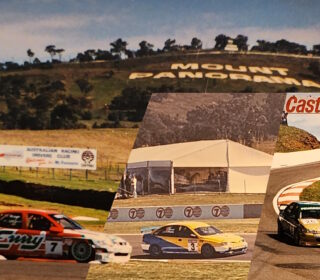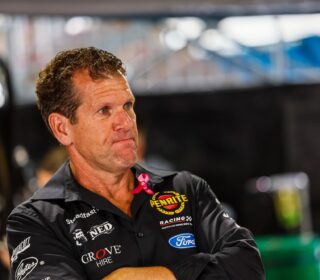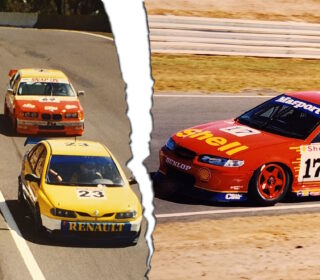Darlington Park: Epic Track, Built & Never Raced On
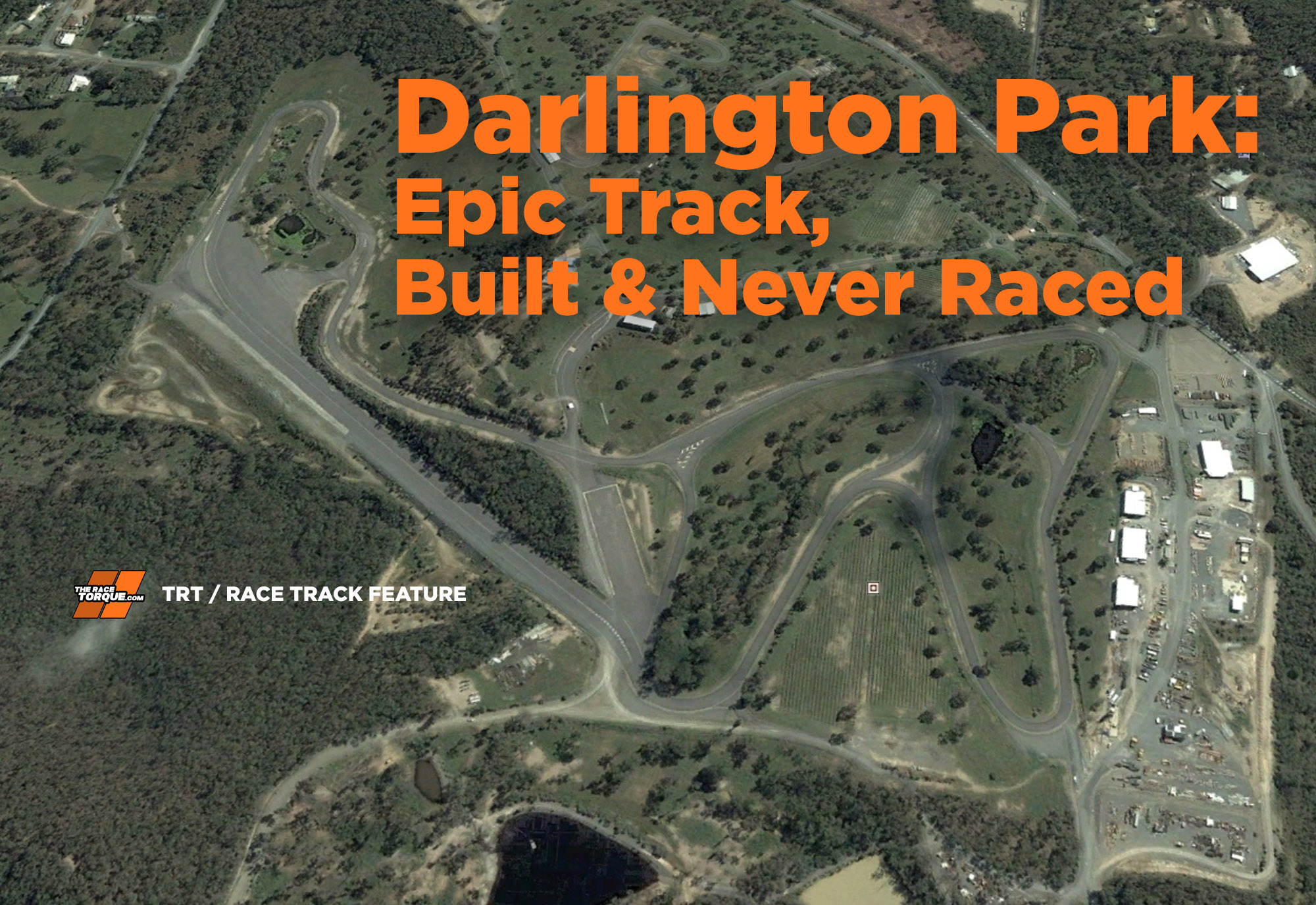
Following the closure of Surfers Paradise International, left with only Lakeside, Queensland was a one-track state. However, before Queensland Raceway was opened, an epic track was built, but never raced on.
In Darlington Park, south-east Queensland had a fantastic permanent circuit, with the potential for the layout to be extended to take on Bathurst with a frightening mountain pass.
Mired in controversy from day one, the awesome ribbon of blacktop through the trees at Yatala was ideally located smack bang halfway between Brisbane and the Gold Coast, and was utilised by some interesting forms of motorsport.
In three parts, The Race Torque will examine the politics, the millions, the murder, the rival plans and the layout that would challenge Mount Panorama, but never play host to a significant event.
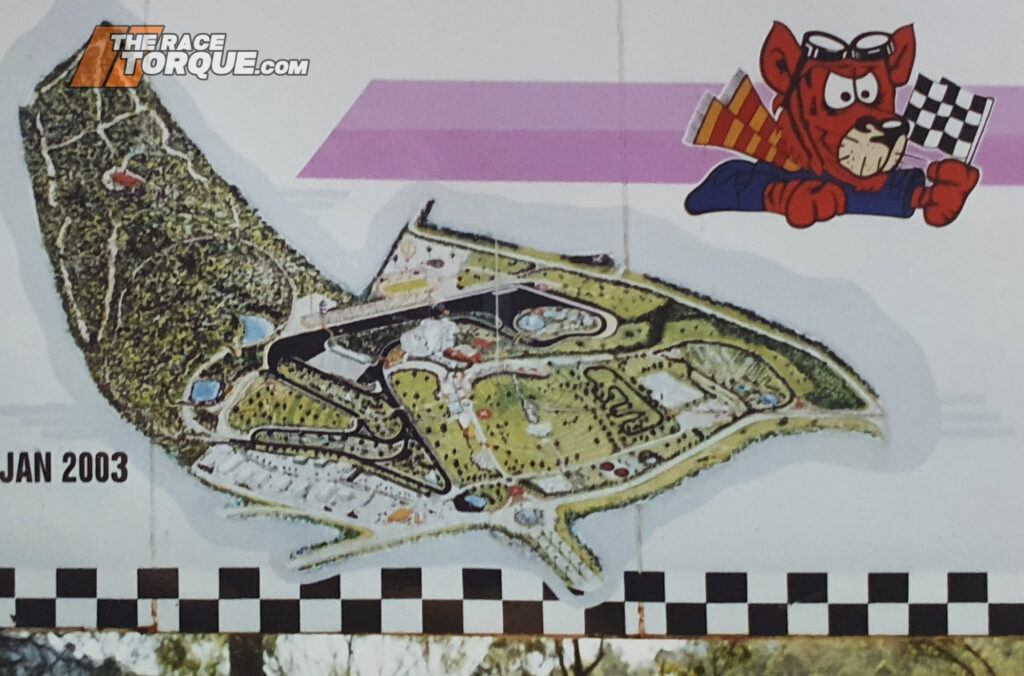
The dream – the 1998 master plan for Darlington Park. Photo: Mark Walker
It Started with a Vision
Like so many race track projects, Darlington Park was kicked into life by a man with a vision.
Tony Stephens was the son of a Gold Coast banana farmer, who went on to be a truck driver, a quarry operator and patent holder.
To paint a picture, he was described as a man who never stood still, and with his experience in moving vast quantities of rocks, building a race track would be a cinch.
It was reported that Stephens acquired the Darlington Park site in 1986. While the local area features semi-rural housing, significant quarrying activity and a motocross track pre-dated any thoughts of the new race track.
“The raceway actually morphed from his vision to create the best driver education centre in the country. That came after he spent two weeks in hospital in Brisbane where he saw the number of young people who were coming in and out of his ward with horrendous injuries from car accidents. When he was released from hospital he came straight home, jumped on a dozer with me in tow and carved out a motor track for the driver education centre.”
Tony Stephens’ son, Tony Jr, to the Gold Coast Bulletin in 2015
The first mentions of the circuit in the motorsport press kicked off in mid-1988.
The initial reports state that design input for the facility was sourced from Tony Longhurst and Frank Gardner, however, before long the project was headed to the courts.
In August 1988, Stephens had lodged an appeal against the local government (which at the time was the Albert Shire Council), who had rejected the approval to seal the circuit.
It was claimed that $2million had already been spent on the project ($1.2million for the land, $850,000 on earthworks), with dirt foundations for the 3.3km track having already been completed.
The opening development phase was set to require another $10million, and a further $3million was required down the track for additional upgrades on the 109-hectare site.
At the time, it was reported that the company had put in place steps to ensure that the local community wasn’t impacted by the circuit, even offering free use of the complex’s facilities to residents.
In October 1988, Racing Car News reported that the circuit had been repositioned in a valley on the property, which would act as a natural sound break, with the peak of the ridge some 50m above the track surface.
The prospect of the circuit was a breath of fresh air for the local motorsport community, who, since the closure of Surfers Paradise International at the end of 1987 had been left with only Lakeside, with many vocal in their support of the project.
By November 1988, Racing Car News celebrated a successful court outcome, with work on the circuit to go ahead, with promotors planning to apply for a round of the following year’s Australian Touring Car Championship.
In December, the Canberra Times reported that the venue would be ready for racing by April 1 the following year. The article mentioned that there was inevitable “talk of a possible Formula 1 race at the track”.
“We still have 1991 as our target, but we’ve heard some bad publicity out of Adelaide saying their crowds this year were down 20 to 25 per cent, so we might be putting in for a grand prix earlier. Darlington Park will be the most modern and safest track in the world – much better than Adelaide. We will be able to accommodate 150,000 people, and half of them would be able to see the whole track.”
Brendon Vine, Tony Stephens’ marketing advisor
The article concluded that the June 18 1989 date abandoned by Calder Park could pave the way for a possible berth on the ATCC calendar.
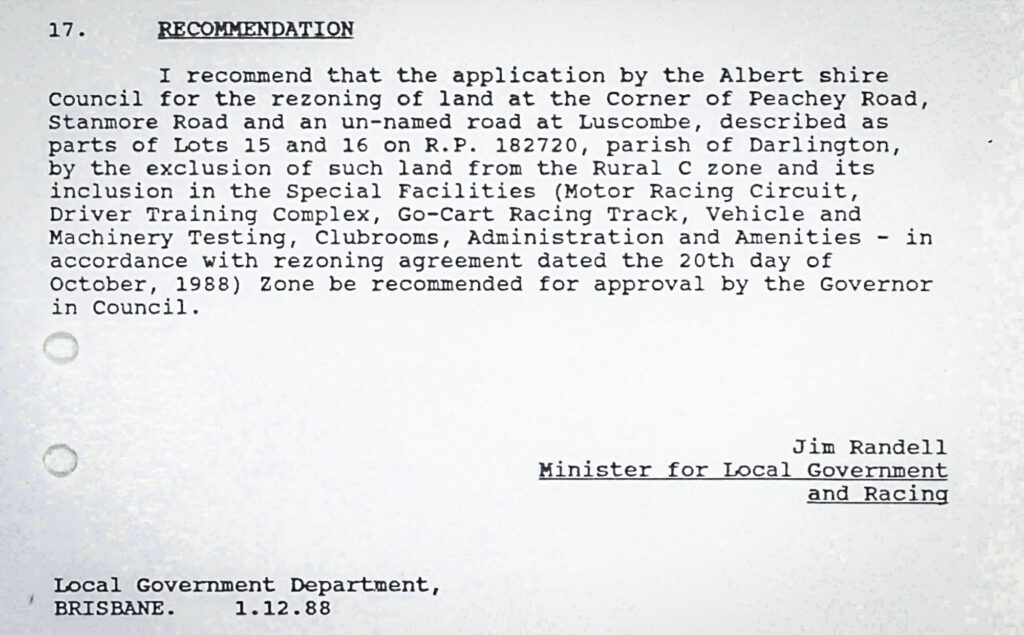
An excerpt from the confidential Queensland Parliament Cabinet Minute regarding the approval of the rezoning of the Darlington Park land.
With safety aspects of Oran Park coming under fire ahead of the venue’s 1989 round of the World Superbike Championship, FIM President Gerry Marshall mentioned that potential alternate sites for the event included Phillip Island, Eastern Creek, and Darlington Park.
“We don’t want to open until all the buildings are erected and the majority of the landscaping is done as well as having the racing track in pristine condition.”
Tony Stephens to Racing Car News, May 1989
This RCN report also noted that problems with noise, traffic and decreasing property values for nearby homes resulting from the project were all in the past.
As was the case through much of its life, in March 1990, the project was once again mentioned in the press as bubbling along in the background, with the circuit reported to have been inspected for a 1A Licence, the highest international grade available, by FISA inspector John Corsmit.
Mr Cormsit noted that achieving this level should not be an issue.
In November 1991, the unsealed dirt track was the host to a portion of the press launch for the new Nissan Pulsar, with other club motorsport events taking to the virgin track in the following years.
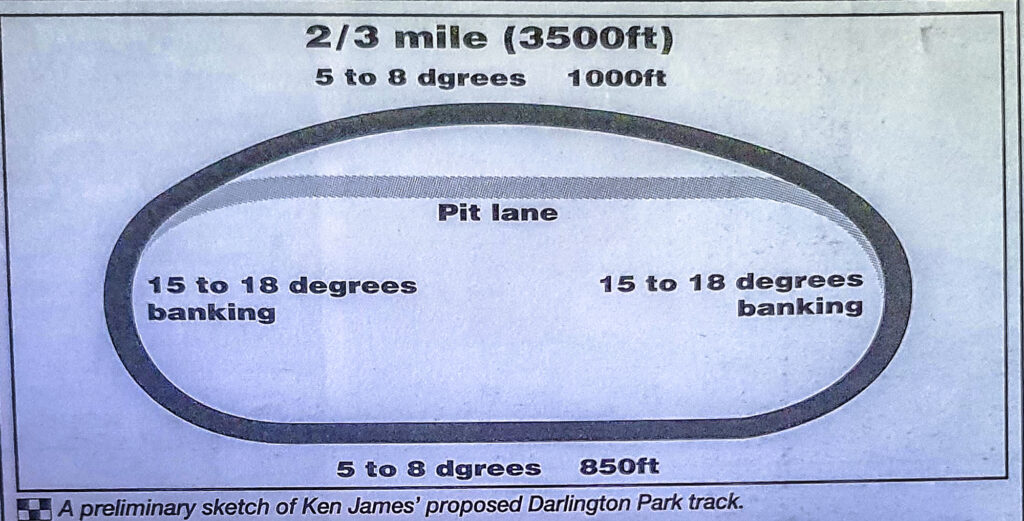
By May 1997, NASCAR driver Ken James put forward a plan to build a 1.07km tri-oval (above), essentially a shrunk-down version of the popular Richmond layout from the USA at Darlington Park.
The report in Auto Action noted that the Gold Coast City Council had by this stage approved the racing circuit, go-kart track and auditorium, although the status of the NASCAR oval hinged on other possible developments of a similar nature at Willowbank.
A couple of months later, a brief in Motor Racing Australia noted that it appeared to be all systems go at Darlington Park, with images of earthmoving equipment in action, plus the firmly shut front gate.
The article speculated that the track would be sealed in June that year.
By March 1998, Darlington Park was back in the press, with AVESCO Chairman Garry Craft set to inspect the facility.
“I understand they have now sealed the track in some way or form, but from what I can gather, the track is pretty raw other than that… If Darlington Park came along and presented a facility to us that was going to be of a standard which was suitable for what we do, then we would certainly look at it.”
Garry Craft, AVESCO Chairman
The story quoted Dick Johnson as saying, “I thought it was a great facility,” while Tim Schenken said that no track licence application had been submitted, and that he would like to bring the venue’s owners up to speed with the current circuit safety regulations.
The article noted that the final venue would feature a 2.4km club circuit, a 4.4km national circuit, and a 7.4km international circuit.
In January 1999, Australian Motorcycle News reported that Darlington Park was open for business, with motorcycle ride days being conducted by the Top-Rider organisation.
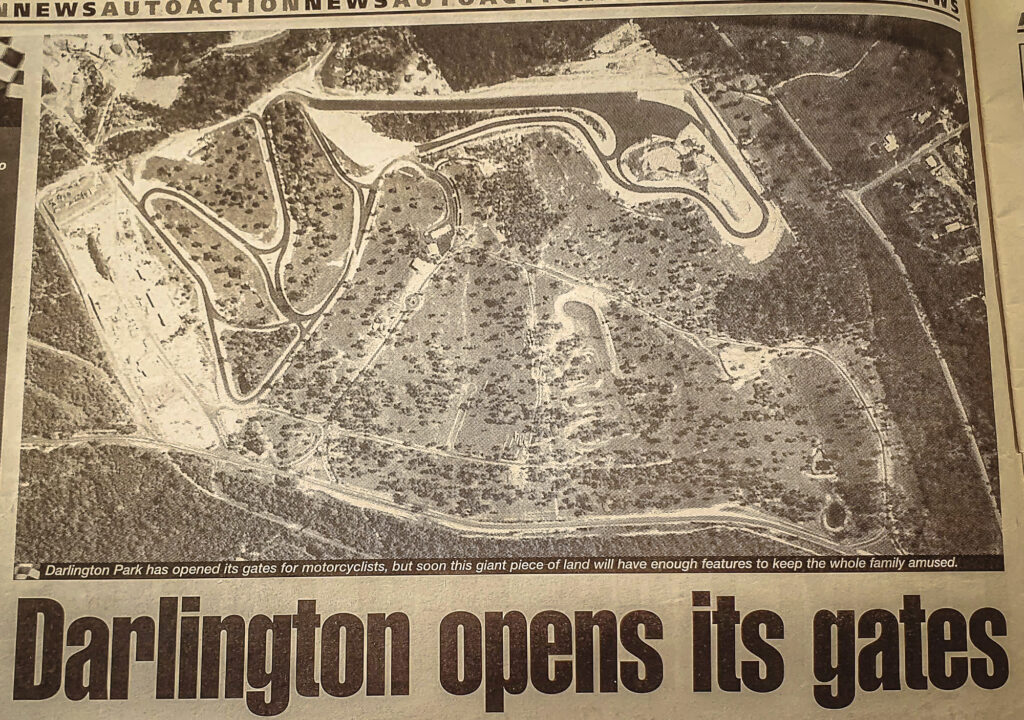
In Auto Action (above aerial image), Tim Schenken noted that CAMS safety inspectors had visited the circuit prior to it being sealed, with Brian Shead, the Chairman of the National Safety Committee, set to re-visit the venue.
Tony Stephens noted that he planned to apply for V8 Supercar and Super Touring events, plus all major motorcycle championships.
Whether there was ever a genuine desire to finish off the race track furniture to complete the venue, it never had a fair chance to come to fruition.
Noise issues became a major hindrance for the complex, with the subject bouncing around the Planning and Environment Court of Queensland, with the Gold Coast City Council on one side and Darlington Park on the other.
“I believe I well and truly comply with those original conditions. I’ve never been over them. I dispute the Council noise readings completely,” Tony Stephens Snr told the ABC in 2004.
Stephens, however, would not see his vision completed, passing away on April 30 2005, with pressure from the ongoing court battles said to have contributed to his heart attack.
The venue was officially closed in August 2005, with communications circulated at the time, blaming constant harassment from the Gold Coast City Council, which made future planning for the complex impossible.
But that is only telling a small portion of the story…
Stay tuned to The Race Torque: in part two, we take a hot lap, look at the master plan, uncover a murder in Yatala, open for business, deal with noise issues, examine the fate of an unused race track and more. Click here for the full story!



